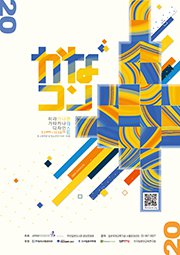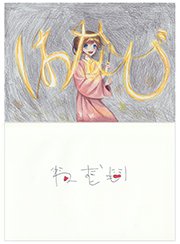The Power of Imagination is Limitless: The Hiragana/Katakana Graphic Design Contest Popularly Known as “KanaCon”!
The Japan Foundation, Seoul
KURONO Atsuko, NOBUOKA Mari
1. Developing Imaginative Powers from Hiragana and Katakana
The Japan Foundation, Seoul holds the “Hiragana/Katakana Graphic Design Contest” – popularly known as “KanaCon” – in which participants compete to produce graphic designs inspired by hiragana and katakana. The contest covers middle school and high school students, and young people aged 14–18, in Korea, and we have been holding it since fiscal 2016.
In the contest’s first year in fiscal 2016, it received 2,566 entries (686 in the middle school student division and 1,880 in the high school student division), but by its fourth year in fiscal 2019, the number of entries had grown by 1.7 times to 4,365 (1,366 in the middle school student division and 2,999 in the high school student division). The contest has thus become an event that attracts participation from a large number of Japanese-language learners. In fiscal 2020, possibly because the number of in-person classes at schools declined due to the impact of the COVID-19 pandemic, the contest attracted 2,391 entries, fewer than the previous year, but a number of entries were unique works overflowing with originality, and we were impressed by the wealth of ideas.
Poster calling for entries
to the fiscal 2020 “Kanacon”
The entries are judged by five individuals, including a design specialist, the Executive Director of The Japan Foundation Seoul, and Japanese-Language Specialists. In looking over the numerous entries while undertaking the judging, the works that the judges are drawn to are the ones where it is possible to immediately determine what letter is depicted or which word has been used to create the motif. Even if the overall design or drawing is skillful, works that require careful inspection to guess what letter (word) is being depicted do not leave much of an impression. Given that the contest is known as “Kanacon,” it is the works that express rich imaginative powers from a word written in kana, or works that depict a concept that we had not even thought of that move us to say “Wow, that’s amazing!” or “I’ve never seen a work like this before!”
In fiscal 2020, the first prize in the middle school student division went to a work that showed a woman holding a firework in her hand and sketching the letters “hanabi” (fireworks), while the first prize in the high school division went to a work that interwove each of the three letters of “ne-mu-i” (sleepy) with three sleepy-looking faces. Other prize-winning works in the fiscal 2020 contest as well as previous works are on display at http://jfkanacon.org/archive. There are many entries that did not win prizes that are nevertheless fascinating works, so by all means take a look.2. The Unlimited Power that “Kanacon” Develops
One of the reasons “Kanacon” is so well-received is that anyone who is studying the Japanese language at middle school, high school or on their own can enter. Any eligibly-aged student (young person) who is learning the Japanese language can take part regardless of their level of the Japanese language, how long they have been learning it, or year at school. Furthermore, the contest can also be adopted by middle school and high school teachers as one aspect of their Japanese-language classes, and it can also be incorporated as a club activity (Japanese-language clubs) or treated as a special challenge (homework during a school vacation, or an assignment for assessment). We believe the reason the contest attracts a large number of works each year is because of the various options like this for introducing it.
Around 10 years ago, classes that incorporate the concept of key competencies and classes that aim to realize amalgamated learning (classes in which learners acquire multiple subjects or multiple skills) began being pursued in Korean secondary education also. Creating works for “Kanacon” is a task that relates to the “knowledge/information processing competency,” “creative thinking competency” and “aesthetic-emotional competency” within the key competencies, and thus makes it possible to develop students’ composite skills. It is also an activity that amalgamates a number of subjects – namely, art/creativity and the Japanese language. “Kanacon” is also an example of how the skills that young people will need to live in the 21st Century can be cultivated naturally and enjoyably.

The prize-winning entries for fiscal 2020 (top: Bae Yun Jin’s winning entry in the middle school student division; bottom: Nho Young Eun’s winning entry in the high school student division)
- What We Do Top
- Arts and Cultural Exchange [Culture]
- Japanese-Language Education Overseas [Language]
- Japanese-Language Education Overseas [Language] Top
- Learn Japanese-language
- Teach Japanese-language
- Take Japanese-Language Test
- Know about Japanese-language education abroad
- The Japanese-Language Institute, Urawa
- The Japanese-Language Institute, Kansai
- Japanese-Language Programs for Foreign Specified Skilled Worker Candidates
- Japanese Language Education for Japanese Children Resident Overseas and for the Descendants of Migrants
- Archives
- Japanese Studies and Global Partnerships [Dialogue]
- JF digital collection
- Other Programs / Programs to Commemorate Exchange Year
- Awards and Prizes
- Publications
